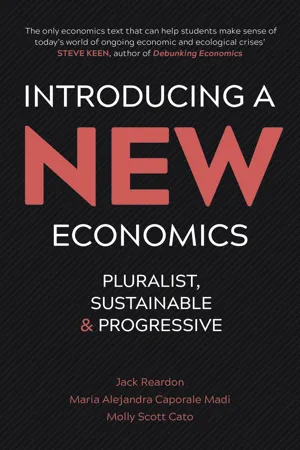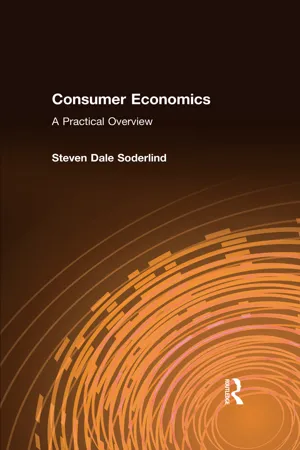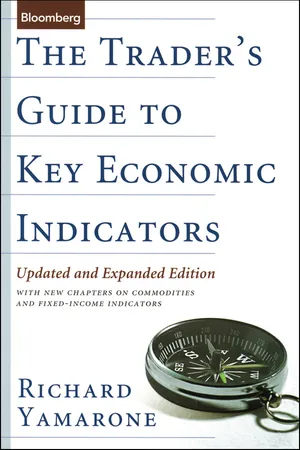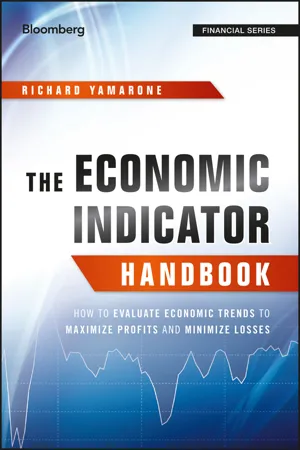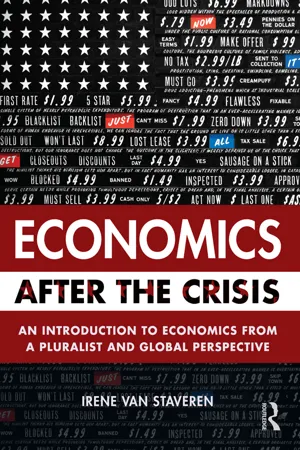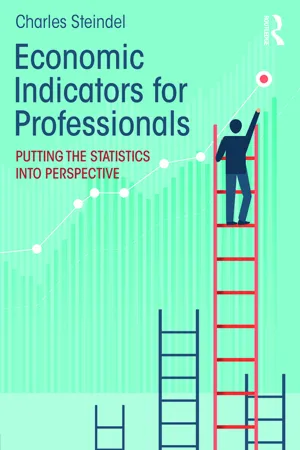Economics
Consumer Spending
Consumer spending refers to the total amount of money spent by individuals on goods and services within an economy. It is a key component of aggregate demand and is influenced by factors such as disposable income, consumer confidence, and interest rates. Consumer spending is a critical indicator of the overall health and direction of an economy.
Written by Perlego with AI-assistance
Related key terms
9 Key excerpts on "Consumer Spending"
- eBook - ePub
Introducing a New Economics
Pluralist, Sustainable and Progressive
- Jack Reardon, Maria Alejandra Caporale Madi, Molly Scott Cato(Authors)
- 2017(Publication Date)
- Pluto Press(Publisher)
As we have seen previously, livelihoods, work and consumption are central to understanding economics as the provisioning of human needs. In contemporary capitalism, and especially in the United States, consumption is the engine of economic growth, comprising approximately 70 per cent of US GDP. As the scale of consumption increases, the sheer volume of production of material goods pressures the ecosystems on which we depend. So while ecological sustainability requires us to recognise the existence of biophysical limits, the need to keep aggregate demand (i.e. the sum total of a nation’s demand for goods and services made by consumers, firms, government at all levels, and foreigners) at sufficiently high levels means that we have to maintain current consumption: in other words, if we do not follow a path of increasing consumption we will condemn the economy to recession. From another angle, consumption is no longer just about meeting our everyday needs but establishes our identity and becomes a substitute for face-to-face human relationships.Household consumption (C) is the portion of disposable income (Y) spent by consumers on goods and services for the satisfaction of immediate needs. And personal savings (S) is that portion of disposable income not immediately consumed. Keynes argued that consumption is stable and positively related to income; that is, as income increases, so does consumption. In addition to income, Keynes argued that consumption depends on both objective (relatively easily measured and thereby controlled) and subjective (whimsical and differing amongst individuals) factors (Keynes, (2010 [1936]: 89–131). Included among the objective factors affecting consumption are:• Fiscal policy: Tax burden and benefits received from the state, such as unemployment compensation.• Credit availability: - eBook - ePub
Consumer Economics: A Practical Overview
A Practical Overview
- Steven Dale Soderlind(Author)
- 2016(Publication Date)
- Routledge(Publisher)
The consumption function is often used to summarize the state of the art in consumer science. Such a function may be applied to individuals, households, or communities—including the national and global communities. The Consumer Workshop at the end of this chapter encourages you to apply it to your own decision making.Summary
Consumption is a difficult concept to pin down, as it is coincident with production and intertwined with saving and investment. To get around definitional difficulties, economists and accountants have agreed on rules for measuring consumption. This gives rise to statistics, testable hypotheses, and the feature that consumer economics can progress in part on a scientific basis.Overall consumption expenditures correlate with several other variables: income, wealth, interest rates, age, and inflation. The pattern of consumption varies with people’s values and self-images. The Table 23.2 summarizes the hypothetical lines of influence between consumption and these explanations.Consumer Workshop
It is one thing to speak of grand correlations and quite another to identify personal sensitivities. For the moment, however, suppose that your behavior is representative of the nation, so that what is true of you will be true for the nation as a whole. Therefore, when you find $100, saving $30 and spending $70, then the nation’s marginal propensity to consume would be 0.70.With you as a midrochasm of the nation, the hypotheses of this chapter come into play: the absolute income hypothesis, the life-cycle hypothesis, the permanent income hypothesis, and so on.In this workshop consider your own personal response to the following situations, showing in each case how much you would change your spending on consumption. Tell how your behavior relates to the various hypotheses from the chapter. - eBook - ePub
The Trader's Guide to Key Economic Indicators
With New Chapters on Commodities and Fixed-Income Indicators
- Richard Yamarone(Author)
- 2010(Publication Date)
- Bloomberg Press(Publisher)
Department of Commerce, Bureau of Economic Analysis; U.S. Department of Labor, Bureau of Labor Statistics Growth in payrolls encourages spending not only by increasing disposable income but also by lifting consumers’ spirits. Another important influence on consumer expenditures is the level of taxation. When marginal tax rates are low, disposable personal incomes rise. With more of their earned income left over, people have a greater propensity to spend; and because Consumer Spending accounts for almost 70 percent of all economic activity, and the United States is traditionally a nation of spenders, economic growth will expand. Consumer Spending The connection between consumer expenditures and economic growth has already been well established. But not all spending is equally revealing of economic trends. Spending on nondurable goods such as food and home-heating fuel tends to be fairly constant, remaining positive even in trying economic times. In contrast, spending on durable goods, which are relatively expensive and long-lived, requires good economic conditions to flourish. In less flush times, consumers aren’t going to head out to buy stereos, furniture, or new china. Therefore, of all the subcomponents in the Personal Incomes and Outlays report, durable goods spending might be considered the most effective in calling turning points in the economy. Figure 11.4 Spending on Consumer Durables and Recessions Source: U.S. Department of Commerce, Bureau of Economic Analysis; National Bureau of Economic Research The chart in FIGURE 11.4 shows that three of the last four recessions identified by the National Bureau of Economic Research—1981- 1982, 1990-1991, and 2001—were accompanied by simultaneous declines in the growth rate in Consumer Spending on durable goods. The 2001 recession broke this pattern, as automakers and certain other retail giants kept consumers buying their products by offering zero percent financing, hefty discounts, and other incentives - eBook - ePub
Inside the Crystal Ball
How to Make and Use Forecasts
- Maury Harris(Author)
- 2014(Publication Date)
- Wiley(Publisher)
In this chapter, the challenge of making accurate Consumer Spending forecasts is approached from both the income and savings perspectives. After reviewing the rich variety of publicly available, but sometimes overlooked, Consumer Spending data, we turn our attention to income formation. That requires an understanding of jobs, wages, transfer payments, investment incomes, and small business profitability. The purchasing power of these incomes will depend on price inflation—a topic that is introduced in the next chapter. Then we tackle the always-topical saving rate issue, analyzing key national determinants such as public confidence, wealth, and demographics. Finally, we look at some recent Consumer Spending subjects, including student debt and household formation.Making and Spending Money
How do Americans spend their money? And how can we go about determining the answer?As discussed in Chapter 2, the first step in forecasting is to understand the particular dependent variable to be modeled and then predicted. For U.S. Consumer Spending, the most comprehensive data set lies in the personal consumption expenditures published monthly by the Bureau of Economic Analysis (BEA). This richly detailed information is presented in both current dollar and real (inflation-adjusted) terms. (See aggregate personal consumption expenditures growth in Figure 9.1 .) For more detailed data on spending by income segment, the Bureau of Labor Statistics' annual Survey of Consumer Expenditures is useful, albeit not particularly timely. (See Table 9.1 - eBook - ePub
The Economic Indicator Handbook
How to Evaluate Economic Trends to Maximize Profits and Minimize Losses
- Richard Yamarone(Author)
- 2016(Publication Date)
- Bloomberg Press(Publisher)
Exhibit 7.6 illustrates the incredibly tight relationship between the growth rate of nonfarm jobs and the rate of Consumer Spending. This occurs for several reasons, but the two most obvious that come to mind include incomes and confidence. If you are gainfully employed, you receive a wage or a salary, granting you the wherewithal to spend. Also, if you have a job—more likely than not—you are upbeat and confident, so you are more likely to make purchases of goods and services.Consumer Spending and Nonfarm Payrolls (Y/Y%)Exhibit 7.6Source: BloombergTherefore, you can see that when the pace of job creation is advancing or sustained at a better than 2 percent pace, consumers tend to spend at a better than 5 percent pace (nominal dollars, noninflation adjusted). Of course, any time that nonfarm payrolls begin to slide, so too does spending. And if that pace in spending is precipitous, then the economy often finds itself in recession. Notice how the declines in payrolls and nominal spending are equal in magnitude.Knowing that the level of employment is critical in the determination of spending, investors should always keep an eye on the pace of job creation. The stronger the rate of growth in employment, the stronger the pace of spending will be. Knowing what consumers are spending their incomes and salaries on can be a very telling indicator of current economic conditions, and may ultimately help forecast GDP.The Fab Five Indicators of Discretionary Spending
To be sure, there is no Holy Grail of economic indicators. Every economic statistic possesses flaws—some more than others. After decades, even centuries, of study and analysis of tens of thousands of indicators, the true gem of economic prediction would have been discovered by now…but it has not.I have identified the following five indicators as some of the most economically meaningful barometers, which I have dubbed over the last 20 years as the “Fab Five.”These are discretionary goods and services; that is, they are not likely to be consumed when economic conditions are deteriorating. Even these insightful measures are not without flaws. But when you look at the trends of these indicators collectively, and employ the commentaries of C-suite executives for the associated industries, you get a very powerful predictor of economic conditions. - eBook - ePub
Economics After the Crisis
An Introduction to Economics from a Pluralist and Global Perspective
- Irene van Staveren(Author)
- 2014(Publication Date)
- Routledge(Publisher)
3Consumption3.1 Consumer demand
3.1.1 Individual consumer demand
This chapter discusses consumer choices. Consumers express agency in consumer markets, under the agency constraints of incomplete information, limited capacity for processing information, risk, uncertainty, and institutions. There are three categories of goods that households demand: final consumer goods , for end use, durable consumer goods , for long-term use and to make domestic labour more efficient, and intermediate consumer goods , which are unfinished goods to which unpaid labour is added to produce final consumer goods. Households demand a variety of services, varying from entertainment (theatre, tourism) to financial services (health insurance, pension savings, and investment plans). The biggest consumer demand by households is for housing: this involves renting at a significant percentage of one’s income. Or it involves buying a durable and non-movable good that is frequently worth several times a household’s annual earnings, which often requires a loan (mortgage), generally varying between 25 per cent and 110 per cent of the house value, with a pay-back period of between 5 and 30 years.Consumer demand in almost every economy in the world today requires purchasing power. In capitalist economies, which are in the majority in our world, purchasing power means money, either cash or in bank accounts. Without money, and hence, some source of income or wealth, one cannot exercise demand in a capitalist market. But not only income matters – prices matter too. Hence, what is relevant for a consumer is real income , which is the purchasing power of income, taking prices into account. The cost of a consumer good, however, is not simply the price paid for it and, hence, a subtraction of available purchasing power. The cost of a consumer good is also its opportunity cost - eBook - ePub
Economic Indicators for Professionals
Putting the Statistics into Perspective
- Charles Steindel(Author)
- 2018(Publication Date)
- Routledge(Publisher)
51 2Consumer SpendingOur examination of the data on the major GDP expenditure components starts with personal consumption. There are misunderstandings and myths about the Consumer Spending numbers. A notable one, though fairly modest, is that most of GDP (the typical fraction is “two-thirds”) consists of Consumer Spending (Morath and Sparshott, 2016). This is misleading on a number of fronts. First, a great deal of Consumer Spending is on imported products, while GDP is a measure of domestic production.1 A more technical concern is that, repeating a point from the last chapter, one cannot actually speak of shares of real GDP. Real GDP is an index number. For convenience and tradition, the index number is usually expressed in terms of the dollars of the base year, but it is technically incorrect, though commonplace, to divide the chained dollar figure reported for a component by the chained dollar figure reported for the total. It is correct, though, to talk about the ratio of current-dollar spending of some GDP component to overall current-dollar GDP, and to talk about the fraction of real GDP growth proximately attributable to growth in a GDP component. On both fronts Consumer Spending looms large, though once again, some of that growth should be corrected for offsetting growth in imports of consumer goods. Figure 2.1 illustrates that nominal Consumer Spending accounts for more than two-thirds of GDP. This share has steadily grown over the last half-century and, even taking into account growth in imports, reinforces the notion that US economic activity and production is increasingly geared toward the consumer. Similarly, Figure 2.2 - eBook - ePub
The World of Consumption
The Material and Cultural Revisited
- Ben Fine(Author)
- 2016(Publication Date)
- Routledge(Publisher)
21The previous paragraph has been primarily concerned with consumer theory at the microeconomic level of demand for particular goods. In estimating aggregate consumer expenditure for macroeconomic modelling purposes, the role of the representative consumer has become more sophisticated. Where previously a behavioural assumption was made, such as a fixed proportion of income being spent, the representative consumer in more recent theoretical developments is presumed to optimise over a lifetime, thereby needing to undertake sophisticated intertemporal decisions and to form expectations about the future path of the economy itself. Again, in so far as this has been associated with theoretical innovation, it is entirely in response to the needs of statistical estimation rather than in any deepening of the understanding of consumption itself. Thus, there is a division between the study of consumption from a macro (overall expenditure) and micro perspective, in spite of 'a common theoretical structure'22 based on the representative consumer with fixed preferences and motivation as previously outlined.Economics, then, has always been flush with a wealth of empirical studies, and the development of the study of consumption has even flourished on the continuing basis of a dialogue between the empirical evidence and the theoretical techniques for handling it. There is always room to re-estimate price and income elasticities of individual or aggregate consumption whether because additional data are necessarily generated with the passage of time or because some new theoretical nicety can be incorporated - whether as a result of computer-enhanced statistical capability or through some incremental concession to the realities of consumption as in the recognition of corner solutions. But these advances in techniques and empirical estimation are both prodigious and in extreme disproportion to the conceptual core that has remained both narrow and unchanging. Whatever the validity and use of these studies, in macroeconomic forecasting or in designing tax proposals, for example, the persisting weakness of economics in consumption theory is illustrated by the ways in which it has not been used. Whilst manufacturers and retailers are well aware of the dependence of demand for their products upon the prices they charge and the income of their potential consumers, they are acutely conscious of other factors and positively seek both to identify them through psychographics etc. and to manipulate them by changing preferences through advertising. Further, the weakness of consumer theory within economics is demonstrated by the limited space it commands in the New Palgrave Dictionary of Economics. This runs to four volumes and over 4,000 pages, but the space devoted to consumption-related topics, depending upon how broadly these are interpreted, is probably less than 100 pages. A topic such as conspicuous consumption warrants an entry of only half of a page!23 - eBook - ePub
The Environmental Impact of Cities
Death by Democracy and Capitalism
- Fabricio Chicca, Brenda Vale, Robert Vale(Authors)
- 2022(Publication Date)
- Routledge(Publisher)
6 Consumer goodsDOI: 10.4324/9781003045847-76.1 Introduction
The economic effect of cities has already been noted in Chapter 1 . Living in cities in turn tends to lead to a larger personal EF than the national average. This chapter investigates and compares the consumption of consumer goods in the 19 cities. The first problem is defining what consumer goods are. The Organisation for Economic Co-operation and Development (OECD) survey of consumer goods and services collects “the prices that purchasers actually pay to sellers to acquire the goods and services specified” (OECD/Eurostat, 2012 :109). The specified services fall into the six groups of Food (including drinks and tobacco); Personal Appearance (clothing, shoes, care of same, care of appearance); House and Garden (including hobbies and toys); Transport, Restaurants and Hotels (including camping and sports equipment); Services (including car and house maintenance, veterinary care, and telecommunication services); and Furniture and Health (including medical products). However, the OECD study is concerned with total household expenditure, so the definition used for consumer goods is very wide. The typical dictionary definition of consumer goods is goods bought to satisfy consumer needs, rather than goods bought by manufacturers for the purpose of making something, but this is not helpful in defining the difference between essential household expenditure, such as on food, and what might be considered expenditure on consumer goods and services, such as buying a television or a ticket to the cinema.Clothing illustrates the divide between what is and what is not essential. Most societies require people to be clothed, but at the same time having more clothes than are strictly needed puts clothing in the consumer goods category. The modern global fashion market accounts for around US$3 trillion annually or about 2% of global GDP. “It is estimated that around the world, about 107 billion units of apparel and 14.5 billion pairs of shoes were purchased in 2016. That equates to every person on the planet buying roughly 13 garments and two pairs of shoes” (Fashion United, 2021 ). Using data from Euromonitor International, Table 6.1
Index pages curate the most relevant extracts from our library of academic textbooks. They’ve been created using an in-house natural language model (NLM), each adding context and meaning to key research topics.
